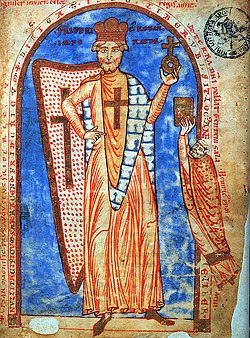Background
The Curia Christi was called to deal with two issues: the conflict, internal to the Empire, between the emperor and the archbishop of Cologne; and the fall of Jerusalem to the Ayyubids. The conflict between emperor and archbishop has been traced to Frederick's privileging the cities of Aachen and Duisburg at the expense of the economy of Cologne. It has also been suggested that the emperor bore a grudge against Philip for engineering the downfall of the emperor's cousin, Henry the Lion, in 1180. Another proposed cause of the conflict was Philip's siding with Pope Urban III over the disputed archbishopric of Trier. Open conflict began when Philip refused to allow an imperial army to cross his territory and Frederick responded by imposing an embargo on Cologne on 25 July 1187.
On 15 August 1187, at a diet in Worms, Frederick began legal proceedings against Philip, who had disobeyed a summons to attend. He was summoned to attend the next diet in Strasbourg, which convened around 1 December 1187. He disobeyed that summons also. At Christmas in Trier, Frederick lamented the fact that he would have to devastate imperial territory to bring Philip to heel. Nevertheless, Philip attended the diet of Nuremberg on 2 February 1188. A final legal decision—and thus Philip's public submission—was postponed to the next diet in Mainz.
The resolution of the conflict was brought about in no small part by the fall of Jerusalem (2 October 1187) and the death of Urban III (20 October). Urban's successor, Gregory VIII, threw himself fully behind a new crusade and moved quickly to resolve his differences with the emperor.
Diet of 27 March 1188 in Mainz
The choice of date for the Curia Christi was loaded with significance. It was scheduled for Laetare Sunday, 27 March, the anniversary of Frederick's coronation as King of the Romans in 1152. The introit for that day's Mass, taken from Isaiah 66:10 ("Rejoice with Jerusalem, and be glad for her, all you who love her; rejoice with her in joy, all you who mourn over her"), aligned perfectly with the purpose of the diet. The designation Curia Christi was Frederick's own. He refused to preside over the assembly himself in acknowledgement of Christ's kingship over kings. There is some doubt, however, whether the throne was really vacant during the diet or whether such references in the sources are literary devices not to be taken literally.
Protection of Jews
Attendees began arriving in Mainz on 9 March. According to a letter sent by Rabbi Moses ha-Cohen of Mainz to his brother-in-law, Eleazar of Worms, a mob gathered in the marketplace intending to invade the Jewish quarter on 26 March (Sabbath). It was dispersed by the imperial marshal Henry of Kalden. The rabbi then met with the emperor, who issued an edict threatening maiming or death for anyone who maimed or killed a Jew. After the diet, on 29 March, Frederick and Rabbi Moses rode together through the streets of Mainz to demonstrate that the Jews had imperial protection. Frederick's measures were successful. While the First and Second Crusades in Germany had been marred by violence against the Jews and the Third Crusade itself occasioned an outbreak of violence against the Jews in England, there was no such violence in Germany in 1188.
Peace between emperor and archbishop
At the diet, peace was made between Frederick and Philip by Cardinal Henry of Marcy. Philip had to swear three oaths: two for his absence at Worms and Strasbourg and one for his defiance of an imperial prohibition on taxing the Jews. He also had to pay a fine of 2,000 marks to Frederick personally and another 200 marks to the court. Symbolically, he was ordered to destroy one of Cologne's gates and to fill in its moat at four places. These symbolic orders were intended only to publicly demonstrated Philip's submission; they were rescinded by imperial prerogative the following day (28 March). Less symbolically, the citizens of Cologne were ordered to destroy their newly built wall in four places. This order was not rescinded.
Crusade
Following the submission of Philip, a letter concerning the fall of Jerusalem was read to the assembly and Bishop Godfrey of Würzburg preached a crusade sermon. Henry of Marcy, who had been charged with preaching the crusade in Germany, probably also read out Gregory VIII's letter Audita tremendi authorising a new crusade. Frederick then asked the assembly whether he should go to the aid of the beleaguered Kingdom of Jerusalem. At the insistence of the assembly, Frederick "took the cross" from Henry of Marcy. He was followed by his son, Duke Frederick VI of Swabia, and by Duke Frederick of Bohemia, Duke Leopold V of Austria, Landgrave Louis III of Thuringia and a host of bishops, lords and knights.
In accordance with the pope's instructions, Frederick proclaimed a "general expedition against the pagans". He set the period of preparation for 17 April 1188 to 8 April 1189 and scheduled a general muster at Regensburg for 23 April 1189, another day of symbolic significance since it was the feast of Saint George, patron saint of knights. To prevent the crusade from degenerating into an undisciplined mob, participants were required to have at least three marks of funding, enough to support oneself for two years.
In a separate piece of business, the Curia Christi summoned the disgraced Henry the Lion to attend the diet of Goslar (25 July–8 August 1188). He was given the option of complete restoration if he joined the crusade. He refused and went into exile in England.
This page is based on this
Wikipedia article Text is available under the
CC BY-SA 4.0 license; additional terms may apply.
Images, videos and audio are available under their respective licenses.
